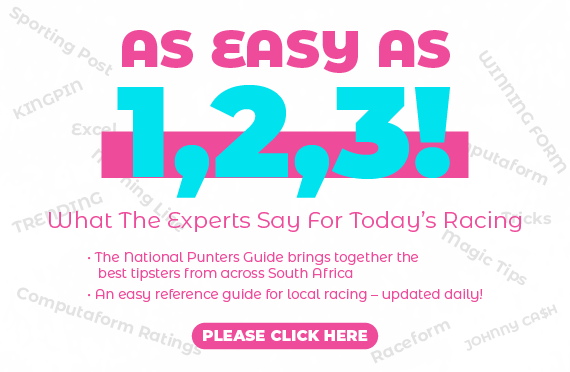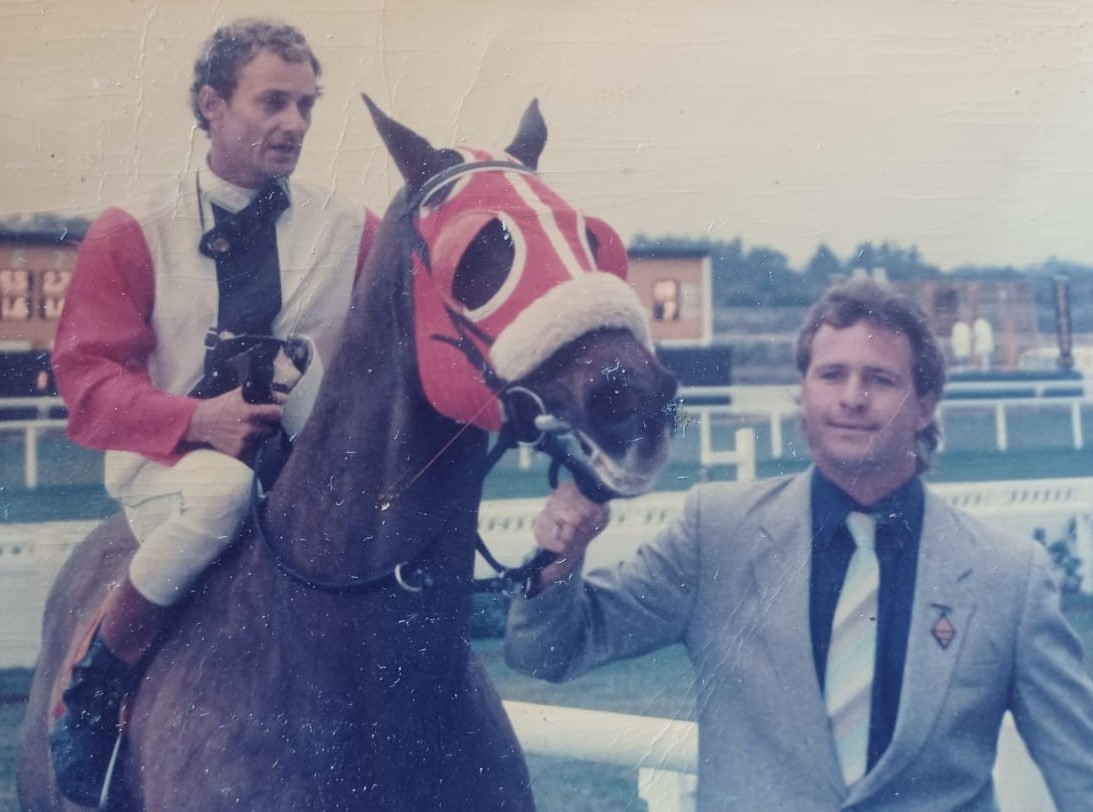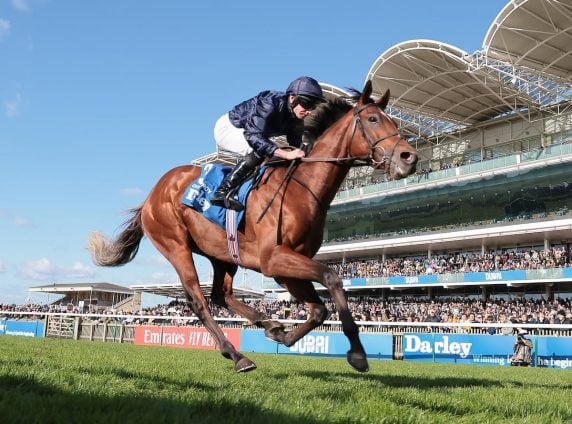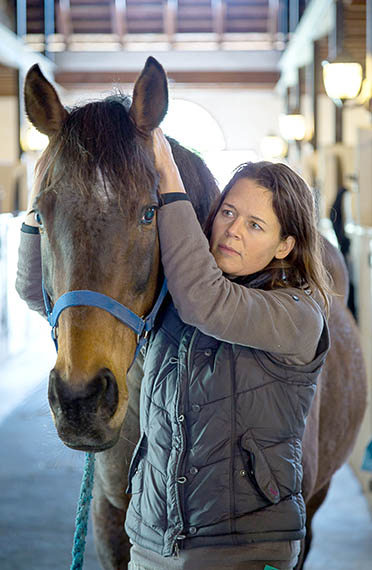
Joey Philips & Skyward Lady
Work is a funny thing. Sometimes it’s something we do to pay the rent and sometimes it’s a calling that we simply have to answer and then sort of figure out the rent thing along the way.
My writing falls very much in the second category and although it might not pay as well or be as glamorous as a lot of folk seem to think, one aspect which really is cross my heart true and fulfils all those romantic imaginings people have about writing, is the treasured privilege of spending time with people who are singularly gifted at what they do.
It is an experience I would not give up for all the horses in the world. The difficult bit lies in trying to translate that talent and brilliance onto the written page, but I guess that’s the bit I get paid for…!
So today I am very pleased to introduce you to Joey Philips, daughter of the celebrated interior design force that is Charlotte Daneel, and Craniosacral Therapist extraordinaire.
What is Craniosacral Therapy?
Craniosacral Therapy forms part of the stable of ‘alternative’ therapies which are becoming increasingly popular as people start to question and reject our dependence on the manufactured chemical substances dispensed as ‘medicine’ and seek more holistic methods of achieving and maintaining wellness.
It is a form of bodywork based on the work of William Garner Sutherland, an American physician and osteopath. He hypothesized that the way the sutures of the skull link together indicated that they were designed to accommodate movement, rather than the more accepted idea that the skull is just a solid, immobile box to house the brain.
Working on the assumption that nature doesn’t do things by accident, he focused and expanded on cranio work and became the first person to claim to feel a rhythmic shape change in the bones of the cranium. He later referred to this motion as the body’s “Primary Respiration.”
Our brain and spinal cord are surrounded by or could even be considered to be floating in cerebrospinal fluid in a closed system which stretches from the head (cranium) right down to the bottom of the spine (sacral bone). Together, the brain and spinal cord are called the craniosacral system and with all the associated nerves that run throughout the body form the central nervous system. In the same way that our circulatory and respiratory systems pulse or pump in accepted rhythms forming our pulse and breathing rates, so our cerebrospinal fluid moves throughout the craniosacral system in regular waves, supplying the brain and nerves with fresh oxygen and nutrients and removing waste substances. Because of the integral role the craniosacral system plays in the health of the rest of the body, any blockage or malfunction can result in sensory, motor or neurological impairment or even malfunction. Craniosacral practitioners monitor the rhythm at key body points, identify the location of obstructions and then assist the natural movement of the fluid and related soft tissue to help the body self-correct.
There is a strong energetic aspect to Craniosacral therapy, which is a little harder to quantify. It is based on the life force, spirit, or ‘chi’ as it is known in the Chinese culture. It works on the premise that the body has an innate intelligence and understanding of its healthy state and rather than manipulate bones or joints back into place, it encourages the system to recognise its incorrect stress postures and heal itself. Joey says that the very nature of how we work with horses means that most if not all working horses suffer from some sort of compression to their system, either from trauma, or simply from the use of headcollars and bits. The body acts as a sort of mirror, with any issues or compressions to the head resulting in a corresponding compromise to the lower part of the body and vice versa. Compressions can manifest in a number of ways ranging from incorrect posture, behavioural issues, trouble working on the correct lead, trouble breathing correctly, headshyness, allergies and headshaking.
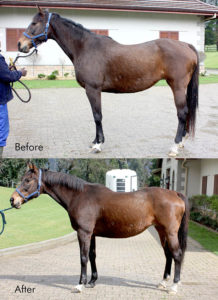
Before and after pictures reveal that issues labelled as conformation
faults are often merely postural issues that can be fixed
I prefer things that I can measure and quantify, so the sort of medicine where someone takes your temperature, puts a stethoscope to your chest and then prescribes you some pills really appeals to my rational thinking. However, after a while, whether by accident or simply because the pills have stopped working, one starts to investigate a little further and look a little deeper. You are now into the territory that my sane, rational, quantitative friends call “woo-woo”. It’s the sort of stuff that used to appear in obscure publications and the occasional broadminded women’s magazine – massage, acupuncture, reflexology and homeopathy.
The sort of stuff that the drug companies don’t really like, but which medical practitioners often resort to when they’ve run out of ideas (or pills!).
And despite there not being a great deal of measurable science behind a lot of these things (mainly because we haven’t designed sophisticated enough instruments yet), a lot of this stuff seems to deliver real results.
Obviously one needs to have an open mind and also to be receptive to this sort of thing and certain therapies will appeal more to some people than to others, but at heart they require a fair amount of intuition, the ability to trust the work and what it tells you and the courage to act on it. Essentially one needs to be open to it. And that’s how we get to Joey.
Who is Joey
Joey Philips was born in Holland. Her father is Dutch and her mother is South African and although she mainly grew up in Holland, she still feels a strong connection to South Africa and travels out here regularly for family visits.
Joey has always had horses and originally grew up wanting to be a vet, although she now jokes that she’s rather glad she didn’t pursue that avenue as she prefers a more in depth approach that includes nutrition and emotional health as part of the overall package. When her 27 year old horse developed Cushings, she started researching equine nutrition and realised that she really wanted to learn more about animal health. Initially pursuing the path of Equine Facilitated Learning, she attended an intensive workshop with Kathy Pike which included round pen sessions in which each student was encouraged to speak their heart’s desire to the horse before entering the ring. Joey’s question was “What should I do with horses?” Over a number of different sessions with different animals, the horses repeatedly approached her and licked her hands. Joey says that she initially joked that her hands must taste nice, but Kathy said “No, there’s a message in there” and Joey realised that it was the answer to her question – she needed to find a way to use her hands to work with horses.
When the student is ready, the master appears
Joey then found a practitioner who was using cranio and osteopathy work and after spending a day watching her work, decided that it was the right path as she felt a particular synergy with the energetic part of the work. Her search for a suitable mentor led to Maureen Rogers, the pioneer in equine Craniosacral work. After studying with Maureen, Joey also trained with the likes of April Battles and studied the work of Dr Regan Golob.
She continues to explore a variety of disciplines and practitioners in order to add to her ‘toolbox’ of therapies which not only add deeper dimensions to her work, but also yield better results.
Joey has been a full-time cranio-sacral therapist for a number of years now and has found that as with humans, horses pick up little niggles along the way, either through injury or stress and often fall into easily identified patterns of discomfort and compensation.
Having the first rib stuck or the hips or pelvis slightly out are common problems, but identify and remove the blockage, help the body to release and re-set itself and the horse will usually make very good progress. Better still, it will avoid the compensation patterns degenerating into further injury.
Joey in South Africa
Through Charlotte Daneel’s association with Beth Brandtner, Joey started treating horses at Nutfield Stud back in February. Manager Jackie Jolliffe was particularly impressed with the work performed on their filly Reflective Image and is convinced it helped her win the tightly contested Winning Edge Handicap on Super Saturday. I went along to watch Joey treat one of the Nutfield broodmare band and was equally impressed. Joey started her session by photographing the horse to record a clear ‘before’ picture, took a history of her life and health and also assessed her movement. Then she got to work, first balancing the horse generally and then addressing in more detail specific problem areas that the initial once over had revealed. The work did not look particularly dramatic in the way that some of the chiropractic or physiotherapy disciplines can.
There were not a lot of big movements or dramatic reactions. Instead, the session consisted of a lot of gentle, simple moves, probably most closely resembling massage and pressure point work, which generated very visible reactions from the mare. But what was most arresting was the feeling of an intensely quiet, but profound and focussed energy that built up throughout the session. Even as an observer, it left you feeling very relaxed and somehow re-grounded. It was also interesting to note that as the session progressed, the mare stopped fidgeting and quietened down completely. As her body softened and released she became visibly more alert, with her eye and demeanour markedly brighter by the end of the session. Joey Philips definitely has a gift.
At the end, the mare was walked out again to assess how much progress she’d made and an ‘after’ photo taken to measure any changes. While some of the changes were subtle, there was a definite improvement in the mare’s overall posture and her body simply looked a lot less strained and tight. It was even more fun to watch the old girl go for a mad gallop around her paddock as soon as she was turned out again.
While one might question what benefits such a treatment would offer a broodmare, the benefits of increased health and fertility will be immediately obvious to any broodmare manager dealing with a tricky mare! And the benefits to working and competitive horses can be even more dramatic.
It was a fascinating morning and I have already booked a session for one of my horses. For anyone who is interested, Joey will be in South Africa until the end of September.
If you would like more information, check out www.joeysark.com or to schedule an appointment, please email [email protected] with a short description of your horse’s issues, a cell phone number and stable address. Sessions usually last approx 1,5 hours and horses will need at least 2 days off after a treatment, preferably turned out.






